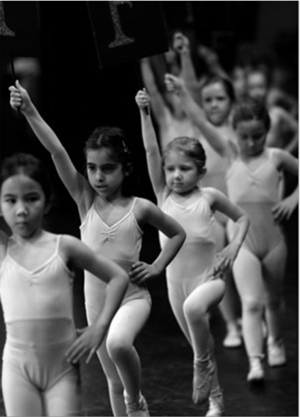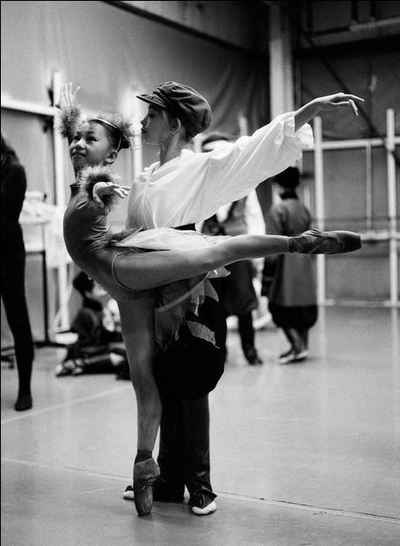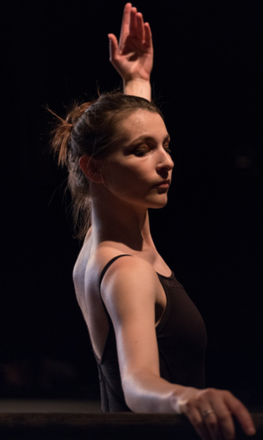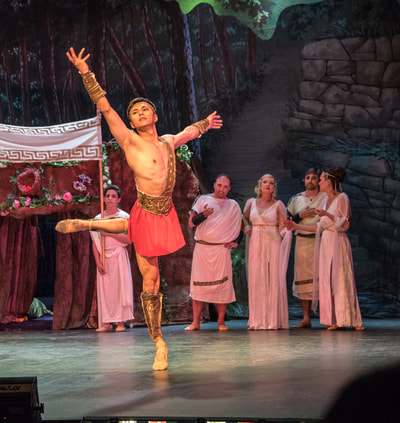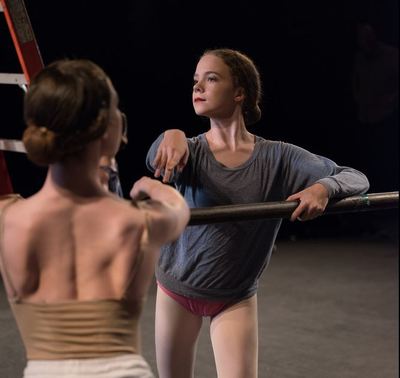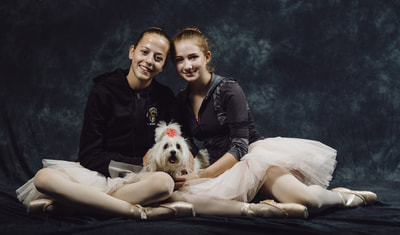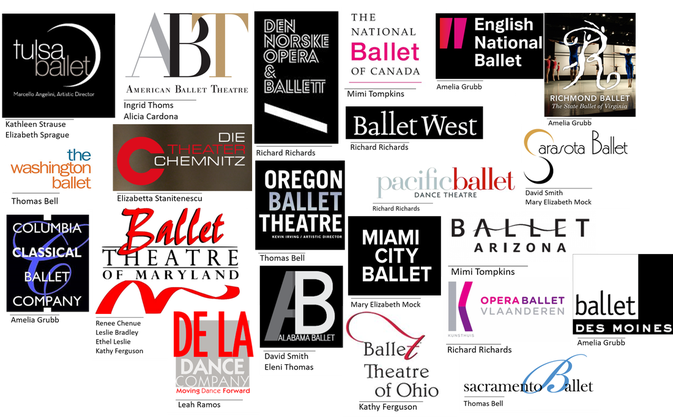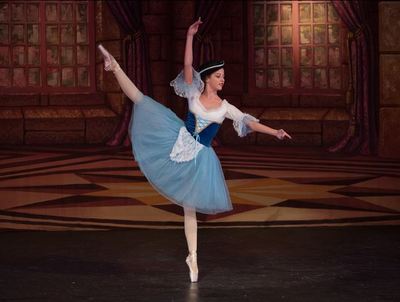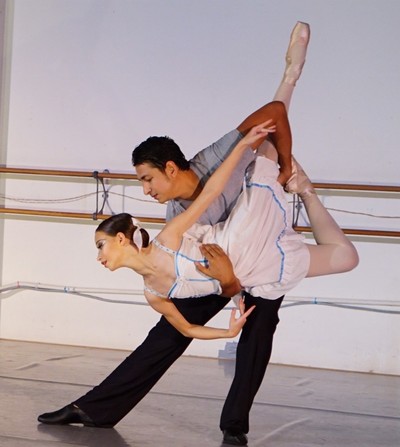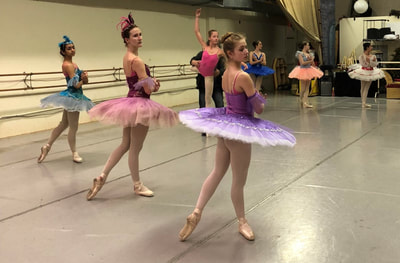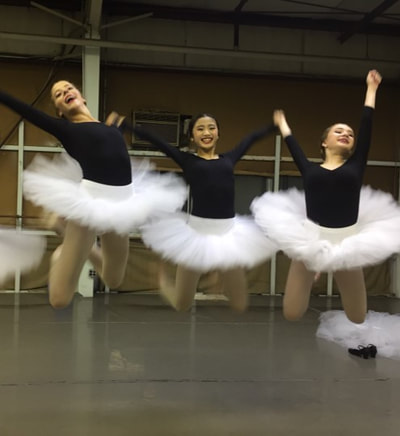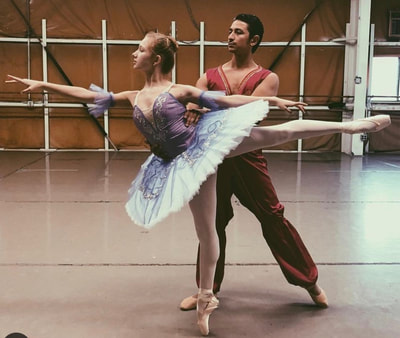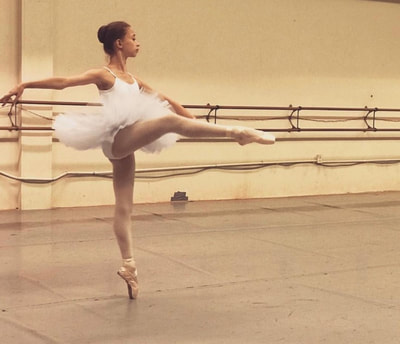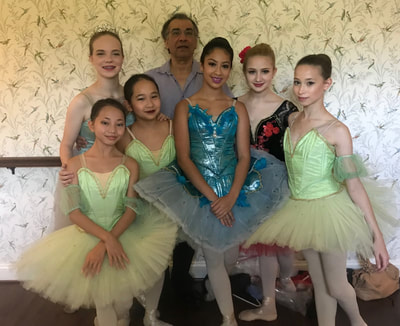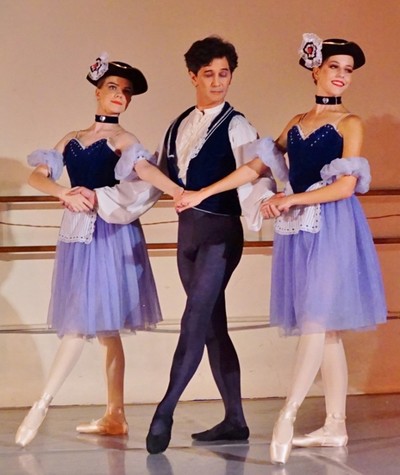Classes
|
On this Page:
Adult Classes Schedule. Curriculum, Dress Code, Tuition options On Ballet for Parents Articles include:
Youth Class information Levels, Curriculum, Registration and Policies Performance Rehearsals Policies, Scheduling. Summer Intensive Program Registration, Tuition - coming soon Video Examples of Youth Classes |
Request information |
Adult Classes
SCHEDULE
Adult Beginner/Intermediate:
CURRICULUM
KMAB offers a comprehensive adult program, which includes Vaganova-based barre training and advanced classes, including adult pointe work.
TUITION
The adult program tuition uses a "class card" system, where classes are purchased either 20 or 10 at a time at a discount, or on a "walk-in" rate. The cards are "hole-punched" when classes are attended.
DRESS CODE
Adults are not asked to wear a uniform, or any particular color or design of leotard or tights. We do, however, prefer that standard ballet-wear (leotard / unitard) and proper ballet shoes be worn in classes at all levels (e.g., no jazz shoes, bedroom slippers, or bare feet).
One option for purchasing optional skirts is through Royall Dancewear, a local woman-owned small business on etsy.com (coincidentally located in Arlington, VA) that provides the uniform skirts for the upper-level classes. Two local stores for purchasing dance wear are Footlights (Springfield, VA, and Silver Springs, MD) and Cinnamon Tree (Herndon, VA). Both offer a 10% discount (use "KMAB 10" for Footlights). Another great online dance wear store is Discount Dance.
SCHEDULE
Adult Beginner/Intermediate:
- Tuesday 7:30
- Saturday 10:00
CURRICULUM
KMAB offers a comprehensive adult program, which includes Vaganova-based barre training and advanced classes, including adult pointe work.
TUITION
The adult program tuition uses a "class card" system, where classes are purchased either 20 or 10 at a time at a discount, or on a "walk-in" rate. The cards are "hole-punched" when classes are attended.
- 20-class card: $350.00
- 10-class card: $200.00
- "Walk-in" class: $25.00
DRESS CODE
Adults are not asked to wear a uniform, or any particular color or design of leotard or tights. We do, however, prefer that standard ballet-wear (leotard / unitard) and proper ballet shoes be worn in classes at all levels (e.g., no jazz shoes, bedroom slippers, or bare feet).
One option for purchasing optional skirts is through Royall Dancewear, a local woman-owned small business on etsy.com (coincidentally located in Arlington, VA) that provides the uniform skirts for the upper-level classes. Two local stores for purchasing dance wear are Footlights (Springfield, VA, and Silver Springs, MD) and Cinnamon Tree (Herndon, VA). Both offer a 10% discount (use "KMAB 10" for Footlights). Another great online dance wear store is Discount Dance.
On Ballet: for Parents
Unfortunately, in the US, there are no restrictions on who can and cannot teach ballet or open a studio; it is possible for anyone to have a ballet school. In other words, anyone who can lease a space and pay for the advertising may do so, regardless of their background or experience in the field. All that is necessary is that they convince YOU that they are qualified. Before you send yourself or your child to a teacher or school, research the teacher's background. REMEMBER: You cannot teach what you could never do!
Always observe a class. Real teachers conduct their classes in an unmistakable way. First, there is never chaos. Classroom protocol is required to learn the material presented. Students who work with professional teachers are always focused and NEVER talk unless they are addressed by the teacher. Does the teacher seem to be prepared? A real teacher does not ever give class in an impromptu manner. Unless the teacher appears to have a clear class plan, this person is either a fraud or is not seriously concerned with the students.
What does the facility look like? It may be beautifully decorated and spotless, but are the floors constructed properly and covered with a dancing surface? Are the studios big enough to allow students over 12 years of age to move in a manner that resembles stage movement? It is not uncommon to see advanced students who move in a stunted manner because they studied in a tiny studio. Also, a proper studio will have adequate mirrors and barres and a ceiling that is high enough for high lifts and jumps. A professional dancer or teacher would find any other conditions unacceptable.
The study of classical ballet is the study of body positions, not of steps or movements. When you go to the ballet and watch dancers in action, you are witnessing something akin to an animated movie where you see one picture after the other flash by so as to look like movement. First, positions are studied, and then the transitions from one position to the other. Finally, the elements of turns, jumps, lifts, and pointe work are incorporated. A good teacher always stresses the correctness of position and avoids encouraging expressions such as looks of longing or “recital smiles”. The artistic aspects of ballet come with the growth of the student. In the perfection of each body position, there exists a built-in dynamic that suggests a certain emotional condition. Ballet is NOT an art of self-expression. Dancers are instruments with which choreographers compose their visions.
Training in classical ballet is based on the formation of habit. Once these habits have been set, there may be no changing the faults that might have been allowed in the initial study. A famous teacher once said “a dancer is like a loaf of bread, if you’ve left something out, you can’t add it after it’s baked.” No words were ever so true. As professional teachers we often see dancers and students work hard to correct mistakes and problems; however, many of them never realize their true potential because it’s nearly impossible to reprogram everything, no matter how hard they try. Teachers that allow less than perfect body position and execution of exercises, particularly at the barre, are to be avoided. It is possible to see if a student has trained with a competent teacher by the way muscles are developed. Amateur teachers leave a signature of over-sized buttocks and thighs because of the lack of stress on turnout. It is a common misconception in the U.S. that forcing turnout is dangerous. However, it is the students and dancers who do not work with correct turnout that suffer chronic injuries.
Be careful of the traps! Trophies, pictures of famous dancers on the wall, and certificates from dance organizations are known by real professionals as meaningless fluff. Amateur teachers use these to acquire credibility and prestige by association, and the amateur dance studio captures its students by presenting the "fun" aspect. On the other hand, the teaching atmosphere should not be excessively harsh or cruel. Students should be corrected constantly, but never insulted. Students need to be guided, encouraged, and nurtured, but not coddled, and the teacher should NEVER appear to be making friends with the class. The pervading atmosphere should be one of mutual respect.
When should the dancer go 'en pointe' ?
When should children be put en pointe ? Pointe work (dancing in pointe shoes) seems to be a mystery among amateur schools and teachers. It is very common for students to be made to wait until they are as old as 12 or 13 years old, and then to be told that they have to acquire the proper strength before they can go "en pointe”. After that, they attend a “pointe class” where students are asked to perform exercises for up to an hour. This is absurd! This approach is akin to thinking that a child should not attempt walking until they have acquired the proper muscles and coordination.
The correct approach is to introduce pointe work into the student’s everyday practice, executing no more than two or three exercises per class. In this way, the students experience the feeling of pointe work while they are as light as possible and can grow into their pointe technique; For a beginner to wear pointe shoes for up to an hour is more of a torture than a lesson.
The Making of a Dancer - What Parents Really need to know
A common misconception of ballet class is that a student goes to class, the teacher shows a step or combination of steps, and the student attempts to memorize and execute. Many think that students follow the teacher as he or she demonstrates various jumps and turns, encouraging students to try harder in an effort get them emotionally excited and fooled into thinking that progress is made, instead of explaining precisely what the goal is and what needs to be accomplished. From the outside, that may be what it looks like and, sadly, this does indeed happen very often.
The first thing to understand is that a class is a lesson, not a workout or a practice session. What is actually happening is that the teacher (if, in fact, we are talking about an actual teacher) arrives at class with material that has been designed to take his or her students closer to the goal: mastery of both technique and artistry. This material is a continuation of previous lessons, gradually bringing students to a new plateau with mental clarity and physical development. The teacher works on their students like a sculptor chipping away at what, hopefully, will be the next masterpiece. Essentially, dancers are products of their teachers.
Of course there are many factors that influence the outcome. Let's break down three of the most important aspects of the study of classical ballet.
First, the School - What are the aims of any given school and how does that school carry out its goals? A school may have some outstanding teachers. However, the Director is, in fact, the decision maker whose professional background, taste, and personal integrity will decide the final outcome. It should be stated that some thought should go into what this person represents - what is their history as a performer, teacher, and professional? - because all will have an impact on how each student is taught.
Few parents are aware that professional instruction is not as lucrative as the recreational (amateur) approach. A very close friend of mine who joined the faculty of a large, well-known school (attached to a professional company) was pulled aside by the artistic director of the school and company, and was instructed not to teach in detail. She told him to just let the students attend the class and struggle along.
Ballet is learned in the classroom settings, and is not taught one-on-one with a teacher, like piano lessons. Some schools will group students by age and others by ability. Both can be a mistake. A 10-year-old student does not belong in a class with a 15-year-old, regardless of the level of material being presented. Teachers of a serious school will present their material and insist on correctness. Not all students find this fun, even though it is necessary. Remember, we are shaping the entire person, not just teaching some steps.
Outside the profession, little is understood about the aspects of what it is that those who work for said organization, admire and work towards. For example, some schools train dancers with the hope that they will one day belong to the New York City Ballet Company. If that is the case, then the training will be aimed in a completely different direction from a school that sees companies that adhere to classical traditions, such as the Mariinsky Ballet as the model. Rarely do parents and children signing up for ballet lessons have a any understanding of how far these aesthetic priorities are in contrast.
Another consideration is the fact that a school is very often maintained to help fund the performing group attached. If that is the case, then enrollment, unfortunately, becomes a major concern and objective. So, if you witness an upper-level class with 30+ students, know that very little actual learning is going on.
Methodology is one of the most important considerations when selecting a school. However, it can also be very misleading, as there is no recipe for training a dancer. Students cannot discern for themselves what should be learned or when to learn it. In fact, students can't even imagine how much they don't yet know. Thus, it is important to know what, if any, method of study is being followed.
It is the trend presently to claim to teach the Vaganova (Russian) method simply because somebody took class from a Russian teacher somewhere. True followers of any given syllabus understand that there exists an aesthetic attached to these methods of training with an actual repertoire targeted. The "method," however, simply suggests what material is introduced to a student and when that should happen. A total lack of method, on the other hand, risks not only the potential of serious injury and deformation of muscular development, but usually renders what looks like a person off the street doing steps. One only need to look at young students dancing classical variations at competitions and know that their development is actually stunted because habits are being formed that cannot be corrected later.
Ultimately, it is up to the teacher, who works at the pleasure of the director, to decide how any given method is used. A student with excellent training will possess professional qualities in all stage action, and will display refinement as well as virtuosity. To know how to dance means so much more than being able to dance.
Secondly, the Teacher - All teachers attempt to bring their students to the level of proficiency they themselves acquired. It is the task of the teacher to mold the artistic personality of the student, to cultivate their artistic taste and musicality. The teacher must develop their students will and work ethic. A teacher with no professional experience is highly unlikely to produce a dancer of high achievement. The old adage "you can't teach what you could never do" is perfectly stated. On the other hand, a dancer is not a teacher. A good teacher knows how to apply any given method guided by their own level of artistry, which takes years of both study and experience.
Even if a teacher is a graduate of a major school of pedagogy in Russia, how to apply this information to young students living in the United States is a problem that can only be solved through considerable contemplation. It has been my observation that many teachers who have trained and worked in Russia fear "upsetting the children" and causing parental retaliation. Consequently, they try to adapt to the American system, depriving their students of the richness of their artistic culture. Conversely, it is very common to see in the U.S. teachers who think they should teach what they themselves thought they were good at. A good example of this is an acquaintance of mine who belongs to the faculty of a prominent ballet company school in the eastern United States. She told me her main interest was to give her students this quality (lyrical), as she waved her arms in circles like a ghost.
Once a method is understood, the teacher must then have the ability to teach to all the different levels under their care. The most common mistake made by well-meaning, yet probably inexperienced, teachers is to teach beginners professional traits (particularly of expression), while not knowing what is age- and level-appropriate. It is a huge mistake to make a star performer out of a young child. Depth of knowledge determines greatness. Ballet is a classical art form, not mere entertainment. Ballet is an etiquette; to move on stage and in life with this etiquette requires a total devotion to the process. The teacher must also find the language for each level they instruct. Methodology provides what steps to do and when to do them, yet it is up to the teacher to decipher these steps, movements, and poses into a language that, at some point, becomes poetry.
As a classical art form, what is so demanding and, in turn, rewarding, is that the perfection of technique is a prerequisite. Like a pianist of concertos and sonatas, every note must be played perfectly, and after the technique has been perfected, interpretation is required to bring a piece to life. It is the same with ballet. Teachers work daily on creating beauty from a living human being; one that, in the end, will become strong, responsive and reliable. A dancer becomes both the instrument and the musician, and must be capable of expressing a wide range of human emotion. A good teacher, like the sculptor or painter, is capable of seeing the work of art waiting to be revealed and working towards these ends.
No two students are alike, making it critically important for the teacher to recognize both the qualities and the deficiencies of their students. Students may be aware of what they like or enjoy doing, but it is up to the teacher to make sure students realize their full potential.
This brings us to the subject of correction. Naturally, there are students who, for whatever reason, are extremely obedient. They will do what is asked dutifully. The teacher is called upon to analyze their students' temperament and gauge their mental fragility. The teacher must know how far to push and insist, or when to be patient.
There are also the stubborn and headstrong. A teacher needs to meet those students head on and, in the battle of wills, the teacher must win. Most of the time, once the student has moved onward and not quit, the young dancer will be grateful and recognize that they were in good hands.
Thirdly-the Parent. Yes! The Parent. The third leg of the stool. The Parent is responsible not for only transportation and tuition, but also for how the student is able to absorb the daily (yes, daily) lessons. First, parents need to understand, as has been stated previously, that classes are not workouts or practice sessions; teachers do not (and should not) attempt to teach through suggestion. The class is strict, not to be confused with mean, and young aspiring students willingly put themselves through a very demanding and disciplined ordeal, some with the intention of making this a life.
Parents need to understand that a dancer must attain professional level skills by the time they are 17 or 18, as professional companies are not interested in a 20-year-old with no experience. Apprentices are taken young and groomed to fit into the company's style and protocol.
Parents, seeing their child's devotion, often make the huge mistake of feeling pity for their pains of labor and often disappointment. Although a birthday party may be skipped or a family reunion missed, know that your child is racing with the clock. To interfere is to diminish the quality of their life, to some extent. Students need to attend every scheduled class and every scheduled rehearsal, performance, and workshop. If the student is truly contemplating a life in the theater, then this is what both parent and student signed up for.
It is natural to complain - we all do it. However, when the student complains about not getting the part that they were hoping for or that they have been overlooked in some way, it is a mistake to think that running to the school and attempting to tell teachers how to do their job is going to make the student happy in the long run. The world of professional arts is competitive and the "everyone gets a trophy" culture has no place there.
Not all students are endowed with the same degree of facility (natural physical requirements), talent (natural comprehension of ballet dynamics), or inspired energy. Some students learn ballet faster and some have superior coordination and can do more right away. Children are raised with varying degrees of exposure to cultural activities (attending concerts, ballets, operas, etc.).
All these things bring students closer to the world of performing arts and ballet. Consequently, some students display more potential for professional ballet. Students everywhere are privately evaluated by their schools and teachers and, of course, some will be groomed with higher expectations. Other determining factors are of the students themselves: does he or she attend extra classes, summer sessions, and show a professional-like attitude in class and rehearsals.?
Participation in performances is as much a part of the training process as the class. A good teacher knows what each students needs to perform, as well as what they are capable of. If a parent wishes to truly support their student, then they must also be committed to the program. Systems work best when allowed to proceed without disruption.
Once you have selected your school, stick to the program. Unfortunately, the teaching of ballet is complicated, and so only a master teacher can recognize another master teacher. Teachers pass down their professional experience like DNA to their students. As an example, did this teacher end their own performing life with a sense of fulfillment? A dancer forced out of a disappointing career is apt to also infuse their own bitterness into their dialogue and create cynicism, jealousy, and the wrong attitude.
For parents to better understand the decisions of their child's teacher, they need to get to know them as well as possible. Since each and every dancer's body is different, and each student possesses a uniqueness of temperament and mentality, it is the teacher's understanding of the student and that teacher's artistic goals that can create what we call Dancers. Obviously, should a student make no progress after a reasonable amount of time, then a change of school is necessary, but it is a huge mistake to go from teacher to teacher, even with teachers that are of the same method or discipline.
In the end, what parents need to know is that ballet classes may look alike, yet can be as different as night and day. Take time to learn about the aesthetics and vision that inspire the school and the director. Although parents may never understand completely what is taking place at the ballet school, when you entrust your child's training to a school or teacher, it is important to then allow them to proceed without disruption. A skilled teacher must make the decisions about what students needs to do and, very often, not do. Material given at the wrong time make the situation worse, just as information that is contradictory cripples a student's confidence.
As a parent, you need to make the informed choice of a school whose directors and vision you respect and whose methodology leads to the level of artistry that supports your dancer's professional aspirations. You need to understand how to support your student's teacher in the transformation of your child into a dancer by communicating with the teachers about what may or may not be right for the student. There will always be the transportation and the purchasing (and washing) of dance wear, but also the important tasks of making sure the student is present and ready to learn at every opportunity that is offered. So, stick with the program, get to know and support the teachers, and watch in wonder as a dancer is created.
- Choosing a Ballet School
- When should a dancer go 'en pointe' ?
- The Making of a Dancer - What parents really need to know
Unfortunately, in the US, there are no restrictions on who can and cannot teach ballet or open a studio; it is possible for anyone to have a ballet school. In other words, anyone who can lease a space and pay for the advertising may do so, regardless of their background or experience in the field. All that is necessary is that they convince YOU that they are qualified. Before you send yourself or your child to a teacher or school, research the teacher's background. REMEMBER: You cannot teach what you could never do!
Always observe a class. Real teachers conduct their classes in an unmistakable way. First, there is never chaos. Classroom protocol is required to learn the material presented. Students who work with professional teachers are always focused and NEVER talk unless they are addressed by the teacher. Does the teacher seem to be prepared? A real teacher does not ever give class in an impromptu manner. Unless the teacher appears to have a clear class plan, this person is either a fraud or is not seriously concerned with the students.
What does the facility look like? It may be beautifully decorated and spotless, but are the floors constructed properly and covered with a dancing surface? Are the studios big enough to allow students over 12 years of age to move in a manner that resembles stage movement? It is not uncommon to see advanced students who move in a stunted manner because they studied in a tiny studio. Also, a proper studio will have adequate mirrors and barres and a ceiling that is high enough for high lifts and jumps. A professional dancer or teacher would find any other conditions unacceptable.
The study of classical ballet is the study of body positions, not of steps or movements. When you go to the ballet and watch dancers in action, you are witnessing something akin to an animated movie where you see one picture after the other flash by so as to look like movement. First, positions are studied, and then the transitions from one position to the other. Finally, the elements of turns, jumps, lifts, and pointe work are incorporated. A good teacher always stresses the correctness of position and avoids encouraging expressions such as looks of longing or “recital smiles”. The artistic aspects of ballet come with the growth of the student. In the perfection of each body position, there exists a built-in dynamic that suggests a certain emotional condition. Ballet is NOT an art of self-expression. Dancers are instruments with which choreographers compose their visions.
Training in classical ballet is based on the formation of habit. Once these habits have been set, there may be no changing the faults that might have been allowed in the initial study. A famous teacher once said “a dancer is like a loaf of bread, if you’ve left something out, you can’t add it after it’s baked.” No words were ever so true. As professional teachers we often see dancers and students work hard to correct mistakes and problems; however, many of them never realize their true potential because it’s nearly impossible to reprogram everything, no matter how hard they try. Teachers that allow less than perfect body position and execution of exercises, particularly at the barre, are to be avoided. It is possible to see if a student has trained with a competent teacher by the way muscles are developed. Amateur teachers leave a signature of over-sized buttocks and thighs because of the lack of stress on turnout. It is a common misconception in the U.S. that forcing turnout is dangerous. However, it is the students and dancers who do not work with correct turnout that suffer chronic injuries.
Be careful of the traps! Trophies, pictures of famous dancers on the wall, and certificates from dance organizations are known by real professionals as meaningless fluff. Amateur teachers use these to acquire credibility and prestige by association, and the amateur dance studio captures its students by presenting the "fun" aspect. On the other hand, the teaching atmosphere should not be excessively harsh or cruel. Students should be corrected constantly, but never insulted. Students need to be guided, encouraged, and nurtured, but not coddled, and the teacher should NEVER appear to be making friends with the class. The pervading atmosphere should be one of mutual respect.
When should the dancer go 'en pointe' ?
When should children be put en pointe ? Pointe work (dancing in pointe shoes) seems to be a mystery among amateur schools and teachers. It is very common for students to be made to wait until they are as old as 12 or 13 years old, and then to be told that they have to acquire the proper strength before they can go "en pointe”. After that, they attend a “pointe class” where students are asked to perform exercises for up to an hour. This is absurd! This approach is akin to thinking that a child should not attempt walking until they have acquired the proper muscles and coordination.
The correct approach is to introduce pointe work into the student’s everyday practice, executing no more than two or three exercises per class. In this way, the students experience the feeling of pointe work while they are as light as possible and can grow into their pointe technique; For a beginner to wear pointe shoes for up to an hour is more of a torture than a lesson.
The Making of a Dancer - What Parents Really need to know
A common misconception of ballet class is that a student goes to class, the teacher shows a step or combination of steps, and the student attempts to memorize and execute. Many think that students follow the teacher as he or she demonstrates various jumps and turns, encouraging students to try harder in an effort get them emotionally excited and fooled into thinking that progress is made, instead of explaining precisely what the goal is and what needs to be accomplished. From the outside, that may be what it looks like and, sadly, this does indeed happen very often.
The first thing to understand is that a class is a lesson, not a workout or a practice session. What is actually happening is that the teacher (if, in fact, we are talking about an actual teacher) arrives at class with material that has been designed to take his or her students closer to the goal: mastery of both technique and artistry. This material is a continuation of previous lessons, gradually bringing students to a new plateau with mental clarity and physical development. The teacher works on their students like a sculptor chipping away at what, hopefully, will be the next masterpiece. Essentially, dancers are products of their teachers.
Of course there are many factors that influence the outcome. Let's break down three of the most important aspects of the study of classical ballet.
First, the School - What are the aims of any given school and how does that school carry out its goals? A school may have some outstanding teachers. However, the Director is, in fact, the decision maker whose professional background, taste, and personal integrity will decide the final outcome. It should be stated that some thought should go into what this person represents - what is their history as a performer, teacher, and professional? - because all will have an impact on how each student is taught.
Few parents are aware that professional instruction is not as lucrative as the recreational (amateur) approach. A very close friend of mine who joined the faculty of a large, well-known school (attached to a professional company) was pulled aside by the artistic director of the school and company, and was instructed not to teach in detail. She told him to just let the students attend the class and struggle along.
Ballet is learned in the classroom settings, and is not taught one-on-one with a teacher, like piano lessons. Some schools will group students by age and others by ability. Both can be a mistake. A 10-year-old student does not belong in a class with a 15-year-old, regardless of the level of material being presented. Teachers of a serious school will present their material and insist on correctness. Not all students find this fun, even though it is necessary. Remember, we are shaping the entire person, not just teaching some steps.
Outside the profession, little is understood about the aspects of what it is that those who work for said organization, admire and work towards. For example, some schools train dancers with the hope that they will one day belong to the New York City Ballet Company. If that is the case, then the training will be aimed in a completely different direction from a school that sees companies that adhere to classical traditions, such as the Mariinsky Ballet as the model. Rarely do parents and children signing up for ballet lessons have a any understanding of how far these aesthetic priorities are in contrast.
Another consideration is the fact that a school is very often maintained to help fund the performing group attached. If that is the case, then enrollment, unfortunately, becomes a major concern and objective. So, if you witness an upper-level class with 30+ students, know that very little actual learning is going on.
Methodology is one of the most important considerations when selecting a school. However, it can also be very misleading, as there is no recipe for training a dancer. Students cannot discern for themselves what should be learned or when to learn it. In fact, students can't even imagine how much they don't yet know. Thus, it is important to know what, if any, method of study is being followed.
It is the trend presently to claim to teach the Vaganova (Russian) method simply because somebody took class from a Russian teacher somewhere. True followers of any given syllabus understand that there exists an aesthetic attached to these methods of training with an actual repertoire targeted. The "method," however, simply suggests what material is introduced to a student and when that should happen. A total lack of method, on the other hand, risks not only the potential of serious injury and deformation of muscular development, but usually renders what looks like a person off the street doing steps. One only need to look at young students dancing classical variations at competitions and know that their development is actually stunted because habits are being formed that cannot be corrected later.
Ultimately, it is up to the teacher, who works at the pleasure of the director, to decide how any given method is used. A student with excellent training will possess professional qualities in all stage action, and will display refinement as well as virtuosity. To know how to dance means so much more than being able to dance.
Secondly, the Teacher - All teachers attempt to bring their students to the level of proficiency they themselves acquired. It is the task of the teacher to mold the artistic personality of the student, to cultivate their artistic taste and musicality. The teacher must develop their students will and work ethic. A teacher with no professional experience is highly unlikely to produce a dancer of high achievement. The old adage "you can't teach what you could never do" is perfectly stated. On the other hand, a dancer is not a teacher. A good teacher knows how to apply any given method guided by their own level of artistry, which takes years of both study and experience.
Even if a teacher is a graduate of a major school of pedagogy in Russia, how to apply this information to young students living in the United States is a problem that can only be solved through considerable contemplation. It has been my observation that many teachers who have trained and worked in Russia fear "upsetting the children" and causing parental retaliation. Consequently, they try to adapt to the American system, depriving their students of the richness of their artistic culture. Conversely, it is very common to see in the U.S. teachers who think they should teach what they themselves thought they were good at. A good example of this is an acquaintance of mine who belongs to the faculty of a prominent ballet company school in the eastern United States. She told me her main interest was to give her students this quality (lyrical), as she waved her arms in circles like a ghost.
Once a method is understood, the teacher must then have the ability to teach to all the different levels under their care. The most common mistake made by well-meaning, yet probably inexperienced, teachers is to teach beginners professional traits (particularly of expression), while not knowing what is age- and level-appropriate. It is a huge mistake to make a star performer out of a young child. Depth of knowledge determines greatness. Ballet is a classical art form, not mere entertainment. Ballet is an etiquette; to move on stage and in life with this etiquette requires a total devotion to the process. The teacher must also find the language for each level they instruct. Methodology provides what steps to do and when to do them, yet it is up to the teacher to decipher these steps, movements, and poses into a language that, at some point, becomes poetry.
As a classical art form, what is so demanding and, in turn, rewarding, is that the perfection of technique is a prerequisite. Like a pianist of concertos and sonatas, every note must be played perfectly, and after the technique has been perfected, interpretation is required to bring a piece to life. It is the same with ballet. Teachers work daily on creating beauty from a living human being; one that, in the end, will become strong, responsive and reliable. A dancer becomes both the instrument and the musician, and must be capable of expressing a wide range of human emotion. A good teacher, like the sculptor or painter, is capable of seeing the work of art waiting to be revealed and working towards these ends.
No two students are alike, making it critically important for the teacher to recognize both the qualities and the deficiencies of their students. Students may be aware of what they like or enjoy doing, but it is up to the teacher to make sure students realize their full potential.
This brings us to the subject of correction. Naturally, there are students who, for whatever reason, are extremely obedient. They will do what is asked dutifully. The teacher is called upon to analyze their students' temperament and gauge their mental fragility. The teacher must know how far to push and insist, or when to be patient.
There are also the stubborn and headstrong. A teacher needs to meet those students head on and, in the battle of wills, the teacher must win. Most of the time, once the student has moved onward and not quit, the young dancer will be grateful and recognize that they were in good hands.
Thirdly-the Parent. Yes! The Parent. The third leg of the stool. The Parent is responsible not for only transportation and tuition, but also for how the student is able to absorb the daily (yes, daily) lessons. First, parents need to understand, as has been stated previously, that classes are not workouts or practice sessions; teachers do not (and should not) attempt to teach through suggestion. The class is strict, not to be confused with mean, and young aspiring students willingly put themselves through a very demanding and disciplined ordeal, some with the intention of making this a life.
Parents need to understand that a dancer must attain professional level skills by the time they are 17 or 18, as professional companies are not interested in a 20-year-old with no experience. Apprentices are taken young and groomed to fit into the company's style and protocol.
Parents, seeing their child's devotion, often make the huge mistake of feeling pity for their pains of labor and often disappointment. Although a birthday party may be skipped or a family reunion missed, know that your child is racing with the clock. To interfere is to diminish the quality of their life, to some extent. Students need to attend every scheduled class and every scheduled rehearsal, performance, and workshop. If the student is truly contemplating a life in the theater, then this is what both parent and student signed up for.
It is natural to complain - we all do it. However, when the student complains about not getting the part that they were hoping for or that they have been overlooked in some way, it is a mistake to think that running to the school and attempting to tell teachers how to do their job is going to make the student happy in the long run. The world of professional arts is competitive and the "everyone gets a trophy" culture has no place there.
Not all students are endowed with the same degree of facility (natural physical requirements), talent (natural comprehension of ballet dynamics), or inspired energy. Some students learn ballet faster and some have superior coordination and can do more right away. Children are raised with varying degrees of exposure to cultural activities (attending concerts, ballets, operas, etc.).
All these things bring students closer to the world of performing arts and ballet. Consequently, some students display more potential for professional ballet. Students everywhere are privately evaluated by their schools and teachers and, of course, some will be groomed with higher expectations. Other determining factors are of the students themselves: does he or she attend extra classes, summer sessions, and show a professional-like attitude in class and rehearsals.?
Participation in performances is as much a part of the training process as the class. A good teacher knows what each students needs to perform, as well as what they are capable of. If a parent wishes to truly support their student, then they must also be committed to the program. Systems work best when allowed to proceed without disruption.
Once you have selected your school, stick to the program. Unfortunately, the teaching of ballet is complicated, and so only a master teacher can recognize another master teacher. Teachers pass down their professional experience like DNA to their students. As an example, did this teacher end their own performing life with a sense of fulfillment? A dancer forced out of a disappointing career is apt to also infuse their own bitterness into their dialogue and create cynicism, jealousy, and the wrong attitude.
For parents to better understand the decisions of their child's teacher, they need to get to know them as well as possible. Since each and every dancer's body is different, and each student possesses a uniqueness of temperament and mentality, it is the teacher's understanding of the student and that teacher's artistic goals that can create what we call Dancers. Obviously, should a student make no progress after a reasonable amount of time, then a change of school is necessary, but it is a huge mistake to go from teacher to teacher, even with teachers that are of the same method or discipline.
In the end, what parents need to know is that ballet classes may look alike, yet can be as different as night and day. Take time to learn about the aesthetics and vision that inspire the school and the director. Although parents may never understand completely what is taking place at the ballet school, when you entrust your child's training to a school or teacher, it is important to then allow them to proceed without disruption. A skilled teacher must make the decisions about what students needs to do and, very often, not do. Material given at the wrong time make the situation worse, just as information that is contradictory cripples a student's confidence.
As a parent, you need to make the informed choice of a school whose directors and vision you respect and whose methodology leads to the level of artistry that supports your dancer's professional aspirations. You need to understand how to support your student's teacher in the transformation of your child into a dancer by communicating with the teachers about what may or may not be right for the student. There will always be the transportation and the purchasing (and washing) of dance wear, but also the important tasks of making sure the student is present and ready to learn at every opportunity that is offered. So, stick with the program, get to know and support the teachers, and watch in wonder as a dancer is created.
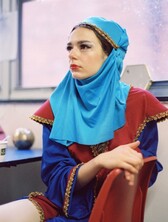
YOUTH CLASSES
The class schedules vary by instruction level, which is determined by the directors during your evaluation appointment.
Classes are held from 1 to 6 days a week, depending upon the level, in the evening hours during the week. Depending on the class level, there may also be classes on Saturday mornings.
Classes last from 30 minutes in duration for the youngest students ranging up to 3 hours for the upper-level combined classes/rehearsals.
Please contact us using the form above to make an evaluation appointment for your child.
The class schedules vary by instruction level, which is determined by the directors during your evaluation appointment.
Classes are held from 1 to 6 days a week, depending upon the level, in the evening hours during the week. Depending on the class level, there may also be classes on Saturday mornings.
Classes last from 30 minutes in duration for the youngest students ranging up to 3 hours for the upper-level combined classes/rehearsals.
Please contact us using the form above to make an evaluation appointment for your child.
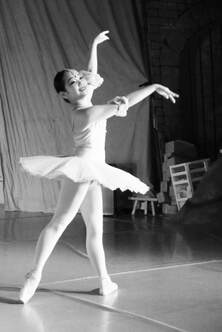
Youth Class Curriculum
The Kintz-Mejia Academy of Ballet uses the Russian ("Vaganova") method of teaching, which has, without question, produced the greatest dancers throughout history. The method is logical and complete, and even our beginning students possess rare qualities of professionalism. From Ballet I and up, pointe work and character dance are included in the curriculum.
At the younger level, beginning at age 3, children are taught the protocol and discipline of classical ballet. Pre-Ballet programs include yogic stretching, ballet mime, and beginning fundamentals of ballet. Upper-level students (Fifth Year and up), on the other hand, receive partnering instruction and choreography of the classical repertoire.
Once a student has reached the intermediate/advanced levels, it is expected that they continue their year-round training by attending the summer intensive. This helps ensure that their training remains uninterrupted and that there is no loss of momentum.
Pre-Ballet (Ages 3-5)
Through the use of music and props, very young children are taught to participate in group activities and direct their imaginations. Students begin the development of musical and spatial imagery with yogic stretching and various choreographic patterns. Later, they begin simple rudimentary barre exercises.
Ballet Prep (Ages 6-7)
In Ballet Prep, students are given preparatory exercises that are studied in greater detail in Ballet I. Beginning at the barre students will learn the correct stance, correct positions of the feet, and execution of movements in the most rudimentary form, along with steps that can be performed in KMAB productions.
Ballet 1 - 3 (Beginning Level) (Ages 8+)
In the First Year, elementary exercises are practiced to develop habits of movement and co-ordination. At first, exercises are learned facing the barre, then with one hand on the barre. For the more correct adaptation of turnout, the series of exercises are learned first to the side, then to the front, and, finally, to the back.
In the Second Year, exercises that have already been learned are repeated in greater quantity and at a faster tempo. The emphasis here is on strength through the use of demi-pointe, as well as exercises on the whole foot.
The Third Year begins the study of center exercises on demi-pointe and movements en tournant (turning). There is also some acceleration of tempo. Here also begins the study of pirouettes and beats.
Ballet 4 - 6 (Intermediate Level)
The Fourth Year focuses on the strengthening of stability (aplomb) and the plasticity of arms and upper body. Of course, as with all levels, new movements are constantly being introduced - first with a preparatory method and then the finished step, movement, or pose.
The Fifth Year continues the mastery of technique, particularly with regard to beats, turns from various preparations, the study of turns in various poses, and a concentration on the development of plasticity and suppleness in moving from one pose to the other. More attention is given to the development of elevation in big jumps at this level.
In the Sixth Year, new movements and preparations are introduced to big jumps. More complication is added to all exercises as well as accelerated tempo. At this level, partnering becomes part of the regular practice, for those who qualify.
The Kintz-Mejia Academy of Ballet uses the Russian ("Vaganova") method of teaching, which has, without question, produced the greatest dancers throughout history. The method is logical and complete, and even our beginning students possess rare qualities of professionalism. From Ballet I and up, pointe work and character dance are included in the curriculum.
At the younger level, beginning at age 3, children are taught the protocol and discipline of classical ballet. Pre-Ballet programs include yogic stretching, ballet mime, and beginning fundamentals of ballet. Upper-level students (Fifth Year and up), on the other hand, receive partnering instruction and choreography of the classical repertoire.
Once a student has reached the intermediate/advanced levels, it is expected that they continue their year-round training by attending the summer intensive. This helps ensure that their training remains uninterrupted and that there is no loss of momentum.
Pre-Ballet (Ages 3-5)
Through the use of music and props, very young children are taught to participate in group activities and direct their imaginations. Students begin the development of musical and spatial imagery with yogic stretching and various choreographic patterns. Later, they begin simple rudimentary barre exercises.
Ballet Prep (Ages 6-7)
In Ballet Prep, students are given preparatory exercises that are studied in greater detail in Ballet I. Beginning at the barre students will learn the correct stance, correct positions of the feet, and execution of movements in the most rudimentary form, along with steps that can be performed in KMAB productions.
Ballet 1 - 3 (Beginning Level) (Ages 8+)
In the First Year, elementary exercises are practiced to develop habits of movement and co-ordination. At first, exercises are learned facing the barre, then with one hand on the barre. For the more correct adaptation of turnout, the series of exercises are learned first to the side, then to the front, and, finally, to the back.
In the Second Year, exercises that have already been learned are repeated in greater quantity and at a faster tempo. The emphasis here is on strength through the use of demi-pointe, as well as exercises on the whole foot.
The Third Year begins the study of center exercises on demi-pointe and movements en tournant (turning). There is also some acceleration of tempo. Here also begins the study of pirouettes and beats.
Ballet 4 - 6 (Intermediate Level)
The Fourth Year focuses on the strengthening of stability (aplomb) and the plasticity of arms and upper body. Of course, as with all levels, new movements are constantly being introduced - first with a preparatory method and then the finished step, movement, or pose.
The Fifth Year continues the mastery of technique, particularly with regard to beats, turns from various preparations, the study of turns in various poses, and a concentration on the development of plasticity and suppleness in moving from one pose to the other. More attention is given to the development of elevation in big jumps at this level.
In the Sixth Year, new movements and preparations are introduced to big jumps. More complication is added to all exercises as well as accelerated tempo. At this level, partnering becomes part of the regular practice, for those who qualify.
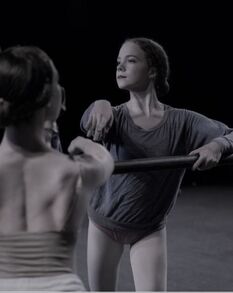
Ballet 7 - 8 (Upper Level Juniors and Seniors)
In the Seventh Year, the work is aimed at polishing all that has been covered thus far, including all the basic movements of classical dance.
The Eighth Year works further on perfection of the vocabulary to make them stage worthy. The emphasis is on performing artistry and virtuosity. Here students become acquainted with various styles of ballet outside of the Russian tradition, such as that Balanchine and Bournonville.
Beginning Teen (Ages 12-15)
For teens new to ballet, we offer a beginning class designed especially for the older student to build a strong foundation and preparation for more advanced studies after learning the basics.
Character Dance Study
Character dance is a relative body of information crucial to the mastery of classical ballet. In essence, character is the study of national styles of dance that are encountered in the classical repertoire. Spanish, Russian, Hungarian, and Polish dance forms, for example, are commonly found in the works of Marius Petipa, the 19th-century choreographer of most of the classical ballets performed around the world. Character is not the study of folk dance, but rather a theatrical expression of it. Students at KMAB begin learning the very basic fundamentals of these styles, beginning at Ballet Prep.
In the Seventh Year, the work is aimed at polishing all that has been covered thus far, including all the basic movements of classical dance.
The Eighth Year works further on perfection of the vocabulary to make them stage worthy. The emphasis is on performing artistry and virtuosity. Here students become acquainted with various styles of ballet outside of the Russian tradition, such as that Balanchine and Bournonville.
Beginning Teen (Ages 12-15)
For teens new to ballet, we offer a beginning class designed especially for the older student to build a strong foundation and preparation for more advanced studies after learning the basics.
Character Dance Study
Character dance is a relative body of information crucial to the mastery of classical ballet. In essence, character is the study of national styles of dance that are encountered in the classical repertoire. Spanish, Russian, Hungarian, and Polish dance forms, for example, are commonly found in the works of Marius Petipa, the 19th-century choreographer of most of the classical ballets performed around the world. Character is not the study of folk dance, but rather a theatrical expression of it. Students at KMAB begin learning the very basic fundamentals of these styles, beginning at Ballet Prep.
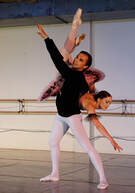
Youth Registration
Registration is ongoing. Those interested in enrolling in any of the training programs at KMAB should use the contact form on our website, email [email protected], or call (703) 506-1039 to make an appointment so the aspiring student can be evaluated and the appropriate program can be offered. On the evaluation day, please be sure the student has all the articles needed for a ballet class, such as ballet shoes and leotard.
Registration is ongoing. Those interested in enrolling in any of the training programs at KMAB should use the contact form on our website, email [email protected], or call (703) 506-1039 to make an appointment so the aspiring student can be evaluated and the appropriate program can be offered. On the evaluation day, please be sure the student has all the articles needed for a ballet class, such as ballet shoes and leotard.
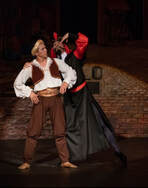
Tuition Policies
- There is no registration fee.
- Tuition for the entire year is due prior to the student's first day of lessons. This tuition is for 10 months of study (September - June).
- Summer Intensive tuition is paid separately.
- Students enrolling after the beginning of the year will be charged an adjusted tuition.
- There are NO REFUNDS once the tuition is paid and the student has started classes.
- Because classes are taught with a syllabus and the study material is specific, no make-up classes are offered. The school is not responsible for missed lessons.
Video Gallery of Classes
Pre-Ballet & Ballet Prep
|
Through the use of music and props very young children are taught to participate in group activities and direct their imaginations. Students begin the development of musical and spatial imagery with yogic stretching and various choreographic patterns. Later they begin simple rudimentary barre exercises.Through the use of music and props very young children are taught to participate in group activities and direct their imaginations. Students begin the development of musical and spatial imagery with yogic stretching and various choreographic patterns, which is then followed by an introduction to rudimentary barre exercises.
|
|
Ballet 1-3 (Beginning)
|
The Third Year begins the study of center exercises on demi-pointe and movements en tournant (turning) and some acceleration of tempo. Also at this level, the study of pirouettes and beats begins.
|
|
Ballet 7-8 (Advanced)
|
In the Seventh Year, the work is aimed at polishing all that has been covered thus far, including all the basic movements of classical dance. The Eighth Year works further on perfection of the vocabulary to make them stage-worthy, with an emphasis on performing with artistry and virtuosity. At this level, students become acquainted with various styles of ballet outside of the Russian tradition, such as that of Balanchine and Bournonville.
|
|
Character Dance Study
|
Character dance is a relative body of information crucial to the mastery of classical ballet. In essence, character is the study of national styles of dance that are encountered in the classical repertoire. Spanish, Russian, Hungarian, and Polish dance forms, for example, are commonly found in the works of Marius Petipa, the 19th-century choreographer of most of the classical ballets performed around the world. Character is not the study of folk dance, but rather a theatrical expression of it. Students at KMAB begin learning the very basic fundamentals of these styles, beginning at Ballet Prep.
|
|
